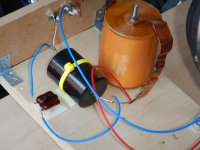Almost off topic, while I personally prefer analog active crossovers, I do keep a
couple passive systems around (Tannoys and SR1's) because I need to evaluate
amplifiers full range and with reactance in the load....

couple passive systems around (Tannoys and SR1's) because I need to evaluate
amplifiers full range and with reactance in the load....

Absolutely not off-topic at all !!
Both active and passive have their pro's and con's. And i like to use their benefits to the max.
So i use a active analog XO to cross over the bass to mid/high. In this way i spare a serious bass-coil. Quality bass coils do exist (have used Mundorf VN390's) but even that quality can not match a proper designed/executed active analog XO.
See picture's. Guess who designed this well-sounding beauty (hint to writer of last reply).
From that same active analog both mid and high is being send to the respective amplifiers for mid and high (so no bass signal). From the respective mid/high amplifiers the mid and high compression drivers get their selected frequency job through a passive XO.
Simple 2nd order so you can invest in those few parts. I got good experience with Mundorf VLCU coils (way better then those rock hard foil coils; that wax impregnation works) and SilverOil caps (didn't prefer the SilverGoldOils).
So i use a mix with of passive and active analog crossovers to good results.
Of course i also tried digital XO's but that was a musical dissapointment.
The only thing i changed at the active analog XO was the power supply. Standard delivered with a ultra lightweight switching affair....almost as an afterthought. A simple but serious lineair affair improved the performance of that XO.
Pictures enclosed of my DIY system. It's tri-amped so i can manage each driver as good as possible. The loudspeaker has a field coil 15" woofer (Fertin 38EX), a Fostex D200a with oversized K-tube as mid and a Von Langa field coil A4000 compression driver with K-tube as tweeter.
Regards, Reinout
Both active and passive have their pro's and con's. And i like to use their benefits to the max.
So i use a active analog XO to cross over the bass to mid/high. In this way i spare a serious bass-coil. Quality bass coils do exist (have used Mundorf VN390's) but even that quality can not match a proper designed/executed active analog XO.
See picture's. Guess who designed this well-sounding beauty (hint to writer of last reply).
From that same active analog both mid and high is being send to the respective amplifiers for mid and high (so no bass signal). From the respective mid/high amplifiers the mid and high compression drivers get their selected frequency job through a passive XO.
Simple 2nd order so you can invest in those few parts. I got good experience with Mundorf VLCU coils (way better then those rock hard foil coils; that wax impregnation works) and SilverOil caps (didn't prefer the SilverGoldOils).
So i use a mix with of passive and active analog crossovers to good results.
Of course i also tried digital XO's but that was a musical dissapointment.
The only thing i changed at the active analog XO was the power supply. Standard delivered with a ultra lightweight switching affair....almost as an afterthought. A simple but serious lineair affair improved the performance of that XO.
Pictures enclosed of my DIY system. It's tri-amped so i can manage each driver as good as possible. The loudspeaker has a field coil 15" woofer (Fertin 38EX), a Fostex D200a with oversized K-tube as mid and a Von Langa field coil A4000 compression driver with K-tube as tweeter.
Regards, Reinout
Attachments
-
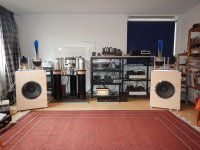 DSCN2572.JPG591.2 KB · Views: 324
DSCN2572.JPG591.2 KB · Views: 324 -
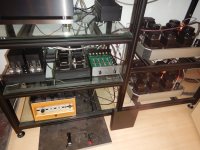 DSCN2564.JPG568.1 KB · Views: 154
DSCN2564.JPG568.1 KB · Views: 154 -
 DSCN2545.JPG690.3 KB · Views: 152
DSCN2545.JPG690.3 KB · Views: 152 -
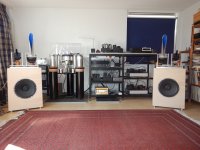 DSCN2668.JPG558.7 KB · Views: 151
DSCN2668.JPG558.7 KB · Views: 151 -
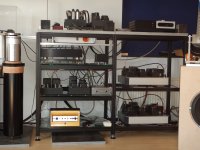 DSCN2667.JPG499.7 KB · Views: 140
DSCN2667.JPG499.7 KB · Views: 140 -
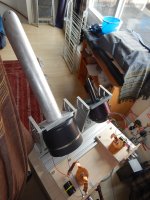 DSCN2603.JPG289.2 KB · Views: 297
DSCN2603.JPG289.2 KB · Views: 297 -
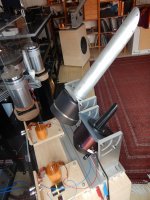 DSCN2604.JPG310.1 KB · Views: 313
DSCN2604.JPG310.1 KB · Views: 313 -
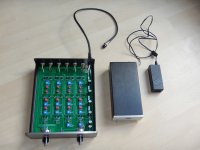 DSCN2651.JPG444.1 KB · Views: 315
DSCN2651.JPG444.1 KB · Views: 315 -
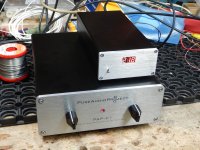 DSCN2641.JPG626.5 KB · Views: 326
DSCN2641.JPG626.5 KB · Views: 326
Thank you in particular for sharing pictures of your set up. I should probably post a few here as well.
I am curious about the horns - my system uses conventional bi-radial horns, and while I have seen pictures the devices you are using you are the first to post something using them.
I am curious about the horns - my system uses conventional bi-radial horns, and while I have seen pictures the devices you are using you are the first to post something using them.
Good afternoon Kevin,
no problem at all sharing pictures / knowledge / ideas / etc; it is the reason for this forum !
But we are seriously off topic here. If you use search on "Karlson K-tube" you will find a couple of active diyaudio-members like Freddi and Pelanj who do a marvelous job exploring this lesser-known system. For me very usefull as i simply don't have the room for proper horns and i do like compression drivers. K-tubes really work but are by definition hilarious looking and will get standard comments like "snow cannon".
Back on topic.
What i really like with passive crossovers is the tweaking. A simple bypass cap can have a real effect on the overall outcome. Try to get rid of the metal glare of some compression driver diaphragms.....tweaking with caps can bring interesting results.
Exactly why i like to use both ways:
- active analog for bass (avoiding that huge coil)
- passive analog mid/high (with easy options)
Pictures of some bypass cap listening tests included
Regards,
Reinout
no problem at all sharing pictures / knowledge / ideas / etc; it is the reason for this forum !
But we are seriously off topic here. If you use search on "Karlson K-tube" you will find a couple of active diyaudio-members like Freddi and Pelanj who do a marvelous job exploring this lesser-known system. For me very usefull as i simply don't have the room for proper horns and i do like compression drivers. K-tubes really work but are by definition hilarious looking and will get standard comments like "snow cannon".
Back on topic.
What i really like with passive crossovers is the tweaking. A simple bypass cap can have a real effect on the overall outcome. Try to get rid of the metal glare of some compression driver diaphragms.....tweaking with caps can bring interesting results.
Exactly why i like to use both ways:
- active analog for bass (avoiding that huge coil)
- passive analog mid/high (with easy options)
Pictures of some bypass cap listening tests included
Regards,
Reinout
Attachments
I know I'll sound old, but active crossovers don't have to be digital! The disadvantage is the cost of multiple power amplifiers, but the crossovers can be much more transparent than the big caps, resistors and inductors needed for passive crossovers.
I was going to say the same thing. I personally don't care for the sound of DSP. I am not opposed to a good electronic active x-over or passives or a combination of both. I just think it sounds better when you take the unaltered digital signal and divide it and filter it in the analog domain, active or passive. Some of the more high end DSP software can sound better then others but to my ear i still prefer analog filters.
Double blind tested?[emoji846]I was going to say the same thing. I personally don't care for the sound of DSP. I am not opposed to a good electronic active x-over or passives or a combination of both. I just think it sounds better when you take the unaltered digital signal and divide it and filter it in the analog domain, active or passive. Some of the more high end DSP software can sound better then others but to my ear i still prefer analog filters.
Absolutely like for like would be hard perhaps..
I was going to say the same thing. I personally don't care for the sound of DSP.
What does a DSP sound like?
i dont understand the big deal with an a/d d/a step. even the cheapest converters are very transparent nowdays. only subjectivist audiophiles whine about this stuff.
so you would rather have a stack of coils and caps in the signalpath?
so you would rather have a stack of coils and caps in the signalpath?
You already do in the D/A and active xover or DSP. In fact, likely MORE parts in the active filtering chain than the passive.
Wolf
Wolf
if a dsp does not outperforme a passive system them you did the settings wrong. as a sidenote some dont even like a flat response.
That is a matter of opinion, and not a blanket statement of fact. I can count on one hand active systems that actually did sound great to me. I can count a lot more passive ones that sounded great. Being closed minded about one format is only going to end up in ridicule, as well implemented systems exist both ways.
Wolf
Wolf
I think one of the biggest issues is the difficulty of using active speakers as a part of a 5.1 or more system.
Digital to digital decoding is a DRM issue that nobody who has the ability to solve wants to solve.
So if I want to build L/C/R I have to go from digital to receiver DSP to analog to digital to crossover DSP to analog, but if I want a pure-er path for music I need to have separate inputs, which means juggling remotes or interfaces... BLEH.
Active speakers end up a lot less "portable" as a result. You can't really hand them down like passive speakers.
Ultimately I decided to ditch surround and a receiver that was really just a fancy & expensive dolby decoding box and just go L/R.
I have also opted for the Hypex Fusion setups. Nice and integrated from a speaker building standpoint. For integration with my TV and remote setup... well, lets just say there is still opportunity for future products to improve upon that.
Digital to digital decoding is a DRM issue that nobody who has the ability to solve wants to solve.
So if I want to build L/C/R I have to go from digital to receiver DSP to analog to digital to crossover DSP to analog, but if I want a pure-er path for music I need to have separate inputs, which means juggling remotes or interfaces... BLEH.
Active speakers end up a lot less "portable" as a result. You can't really hand them down like passive speakers.
Ultimately I decided to ditch surround and a receiver that was really just a fancy & expensive dolby decoding box and just go L/R.
I have also opted for the Hypex Fusion setups. Nice and integrated from a speaker building standpoint. For integration with my TV and remote setup... well, lets just say there is still opportunity for future products to improve upon that.
I see that many people consider active crossovers as a one way street to go digital. However there are solutions to use fully analog devices.
I understand the argument against a multitude of opamps but (to quote Douglas Self) most recordings, analog or digital, have passed through more opamps than we can count during the recording, mixing and down mixing process.
I find that the most compelling argument against active systems being that active setups (active crossovers, amps and speakers) need to be designed as a system. Crossovers need to be configured for the transfer function suitable for each driver, amps need to be sized accordingly and the drivers need to be part of the overall consideration and design. That goes against the "instinct" of most people that want to choose a good sounding loudspeaker, match it with a nice, powerful enough amplifier and get going.
Indeed, unless one buys a commercial active system that was engineered as a product (i.e. build a system out of off-the-self components or diy them) we end up in a spaghetti of cables, low level signal and high level signal. But again, with some thought, that can be overcome.
Active solutions have several interesting advantages.
An active, ,ow signal level crossover can be more precise and tailored and not have the losses of a high level passive one.
Amplifier power is better utilized. So one can easily afford more headroom (and I have personally experienced the importance of that, even in passive setups).
The load to each amplifier is simpler. The output stage of the amplifiers will be happy 🙂
Low frequency clipping will not affect the midrange.
One can choose a powerful solid state amplifier for the low frequencies and a nicer class A for the mid and highs. (That however can be done with bi-amping and is a great solution).
One avoids all the headaches about what capacitors to use for the crossovers and getting expensive aircore inductors.
Turning on (and off) the system, especially if it's a diy one, is a engaging ceremony in itself. Like configuring missiles for launch (stolen from an earlier post, I liked that. My system is just about like that, even being passive).
I understand the argument against a multitude of opamps but (to quote Douglas Self) most recordings, analog or digital, have passed through more opamps than we can count during the recording, mixing and down mixing process.
I find that the most compelling argument against active systems being that active setups (active crossovers, amps and speakers) need to be designed as a system. Crossovers need to be configured for the transfer function suitable for each driver, amps need to be sized accordingly and the drivers need to be part of the overall consideration and design. That goes against the "instinct" of most people that want to choose a good sounding loudspeaker, match it with a nice, powerful enough amplifier and get going.
Indeed, unless one buys a commercial active system that was engineered as a product (i.e. build a system out of off-the-self components or diy them) we end up in a spaghetti of cables, low level signal and high level signal. But again, with some thought, that can be overcome.
Active solutions have several interesting advantages.
An active, ,ow signal level crossover can be more precise and tailored and not have the losses of a high level passive one.
Amplifier power is better utilized. So one can easily afford more headroom (and I have personally experienced the importance of that, even in passive setups).
The load to each amplifier is simpler. The output stage of the amplifiers will be happy 🙂
Low frequency clipping will not affect the midrange.
One can choose a powerful solid state amplifier for the low frequencies and a nicer class A for the mid and highs. (That however can be done with bi-amping and is a great solution).
One avoids all the headaches about what capacitors to use for the crossovers and getting expensive aircore inductors.
Turning on (and off) the system, especially if it's a diy one, is a engaging ceremony in itself. Like configuring missiles for launch (stolen from an earlier post, I liked that. My system is just about like that, even being passive).
What does a DSP sound like?
Let me rephrase that. I don't care for the way DSP colors the sound. Better?
Double blind tested?[emoji846]
Absolutely like for like would be hard perhaps..
No double blind tests needed.
I will admit that todays modern DSP is a lot better then it was even just a few years ago and it is probably getting harder to tell the difference and yes maybe I might not be able to tell the difference all the time in all instances but that's not what we are talking about here. The question asked was a very broad generalized question that I gave a very broad generalized response to. But what I like and how I do things are always subject to change and I could easily find my way to the world of DSP but as of today I don't really see it as all that appealing. This is of course just my highly subjective personal opinion.
In my opinion there can't be many reasons. Is it about the fun designing it? Lets hear your opinion
Non.
Active / Bi Amp
By Mr. Rod Elliott of ESP,
Good read, and very informative !
BiAmp (Bi-Amplification - Not Quite Magic, But Close) - Part 1
By Mr. Rod Elliott of ESP,
Good read, and very informative !
BiAmp (Bi-Amplification - Not Quite Magic, But Close) - Part 1
I like passive crossovers because of the simplicity, i do not like multiple amps and boxes and cables and what else, and then get my family to control it all - forgettaboutit.
But i do think dsp based system will totally rule the consumer audio world very soon and forever, even so for wilson audio and the like
But i do think dsp based system will totally rule the consumer audio world very soon and forever, even so for wilson audio and the like
Just 1 multicore cable from the speaker to the casting for the amps, dsp and a pot as preamp.
So much more pasta comparred to passive speakers...🙄
So much more pasta comparred to passive speakers...🙄
What are your reasons to choose passive over active crossovers?
In my opinion there can't be many reasons. Is it about the fun designing it? Lets hear your opinion
A desperate desire to view the matter as though it is a competition, then foist my opinions on others if they happen to use something that suits their requirements, but which I don't happen to prefer myself. 😉
- Home
- Loudspeakers
- Multi-Way
- What are your reasons to choose passive over active crossovers?
